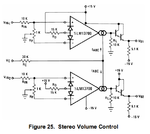BrunoARG
Full Member level 4
- Joined
- Aug 15, 2014
- Messages
- 214
- Helped
- 38
- Reputation
- 76
- Reaction score
- 38
- Trophy points
- 28
- Location
- Buenos Aires, Argentina
- Activity points
- 2,177
Hello everyone.
I am designing a medium power audio amplifier which is likely to heat up as every power driver.
What I want to do is an analog variable gain amplifier which decreases its gain when the temperature rises. It will be useful to protect the amplifier driver from burning due high current.
The problem I come up with is how will I make an analog variable gain amplifier. I thought about an opamp backfed with a FET transistor, which RDS would vary according to a gate voltage. The problem is that the gain/temp would not be linear.
Other way I found to solve the problem is a NTC connected as feedback resistor coupled to the heat sink. When it gets too hot the gain would decrease till stabilize in a safe working output voltage.
I have a doubt with those variable resistance devices non-linearity. Could it affect the amplifier working? could it generate any distortion? Is there another way (commonly used) to protect amplifiers from burning? I thought of a zener limiting the input voltage but it will certainly generate distortion at a point.
Thank you in advance.
I am designing a medium power audio amplifier which is likely to heat up as every power driver.
What I want to do is an analog variable gain amplifier which decreases its gain when the temperature rises. It will be useful to protect the amplifier driver from burning due high current.
The problem I come up with is how will I make an analog variable gain amplifier. I thought about an opamp backfed with a FET transistor, which RDS would vary according to a gate voltage. The problem is that the gain/temp would not be linear.
Other way I found to solve the problem is a NTC connected as feedback resistor coupled to the heat sink. When it gets too hot the gain would decrease till stabilize in a safe working output voltage.
I have a doubt with those variable resistance devices non-linearity. Could it affect the amplifier working? could it generate any distortion? Is there another way (commonly used) to protect amplifiers from burning? I thought of a zener limiting the input voltage but it will certainly generate distortion at a point.
Thank you in advance.

